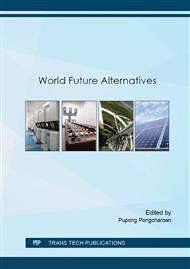p.124
p.130
p.136
p.142
p.151
p.159
p.165
p.170
p.177
Effects of Fresnel Len Application on PV Module Performance
Abstract:
Effects of shading and blocking of solar radiation intensity through Fresnel lens onto solar cell were investigated in this work. Fresnel lens was made of polyvinyl chloride to concentrate the solar radiation onto the polycrystalline silicon solar cell with the 0.767 m x 0.670 m in size and no cooling under the solar panels. The temperature and efficiency comparisons between solar module with and without Fresnel lens were observed. The performance of the two modules overtime is assessed by monitoring the characteristic I-V and P-V curves. The maximum efficiency of the solar panels with Fresnel lens and without Fresnel lens in each hour was approximately 5-6.7% and 8.8-11.5%, respectively. This lower efficiency of PV module with Fresnel lens was a result of unsuitable distance of Fresnel lens that operated with the PV module.
Info:
Periodical:
Pages:
177-181
Citation:
Online since:
June 2016
Authors:
Keywords:
Price:
Сopyright:
© 2016 Trans Tech Publications Ltd. All Rights Reserved
Share:
Citation:


